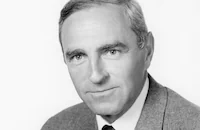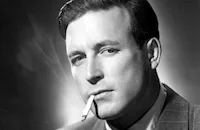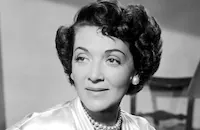Bodyguard

Brief Synopsis
Cast & Crew
Richard O. Fleischer
Lawrence Tierney
Priscilla Lane
Philip Reed
June Clayworth
Elisabeth Risdon
Film Details
Technical Specs

Synopsis
After he is suspended from the force for acting without proper authority, Los Angeles police detective Mike Carter hits his confrontational superior, Lieutenant Borden, and is fired. Later, the unemployed Mike is approached at a baseball game by Freddie Dysen, the nephew of meatpacking heiress Gene Dysen. Freddie offers Mike $2,000 to protect Gene, whose life has been recently threatened, but Mike refuses to consider the job. That night, when Mike finds an envelope containing $2,000 under his girl friend Doris Brewster's apartment door, he goes to the Dysen mansion in Pasadena. Mike angrily returns the cash to Freddie, but as he is leaving the house, gunshots are fired by an unseen assailant. The elderly Gene, the intended target, is unhurt, but Mike decides to take Freddie's offer, even though Gene insists the threats are not serious. A few hours later, Mike discovers Connie, Gene's secretary, digging the assailant's bullets out of the wall and accuses her of being involved in the attack, a charge she hotly denies. Mike then follows Gene and her butler, Peter, to a downtown slaughterhouse, where he is knocked out by another unseen attacker. When Mike awakens, he finds himself in his car with Lieutenant Borden's corpse next to him. He then sees a train barreling toward the car, which is stuck on some tracks, and jumps to safety moments before the ensuing collision. Knowing that he will be accused of Borden's murder, Mike asks Doris, who works as a secretary in the homicide office, to check Borden's files and summarize on a dictagraph recording all of the cases Borden investigated in the last two years. Mike arranges to pick up the recordings at an arcade and goes to the Dysen meatpacking plant. There Mike learns that Alex Stone, a government meat inspector with bad eyesight, was accidentally killed by a Dysen meat slicer the previous year. After Mike is kicked out of the plant by Connie and foreman Fenton, he goes to the arcade and listens to Doris' recordings. Apprised by Doris that Borden was the investigating officer on the Stone case, Mike, whose photograph has been published in the newspapers, takes a cab to the Dysen mansion. Although Gene insists that her late-night excursion to the slaughterhouse was routine business, Mike remains suspicious and visits Stone's brother Adam in San Pedro. From Adam, Mike learns that Stone's hobby was building miniature boats and, now doubting claims that Stone was nearsighted, has Doris drive him to see Briller, the optometrist who had verified Stone's myopia in Borden's report. Posing as a customer, Mike tries to question Briller about Stone, but is attacked by a thug as Briller is examining him. Mike overwhelms both the thug and Briller and then, aided by Doris, eludes a policeman who happens to be in the office. While Mike then breaks into the lens company that had prepared Stone's prescription, Doris sneaks off to the Dysen plant to question the nightwatchman who was on duty at the time of Stone's death. At the lens company, Mike locates Stone's prescription, which shows that he had nearly perfect vision, and arranges for Captain Wayne, the head of homicide, to meet him at the Dysen mansion. Doris, meanwhile, comes across Fenton and Freddie in the plant and, while hiding in an adjoining office, sees the foreman injecting liquid into the meat. As she continues to spy on Freddie and the nervous Fenton, Mike questions Gene at her home about the Stone case. Gene finally admits that Freddie had told her that Fenton, who is Connie's ex-convict brother, was injecting water into the meat to increase its weight and had implicated Fenton in the inspector's death. After Doris calls Mike to report her discovery, Mike steals Wayne's police car before the captain can arrest him and rushes to the plant. Still hiding, Doris, meanwhile, sees Freddie shoot Fenton after admitting that he killed the corrupt Borden for "getting too greedy." As Freddie is about to chop up Fenton's body with a meat cleaver, Doris accidentally reveals herself to him. The still-armed Freddie pursues Doris through the plant, but is stopped by Mike, who knocks him out just as Wayne arrives. Later, the reinstated Mike, who has proven that Freddie knew about his problems with Borden and had set him up, drives off for a long World Series honeymoon with Doris.

Director

Richard O. Fleischer
Cast

Lawrence Tierney

Priscilla Lane

Philip Reed

June Clayworth

Elisabeth Risdon

Steve Brodie
Frank Fenton
Charles Cane
Lucien Prival

Steven Flagg
Marcelle Corday
Ben Frommer
W. J. O'brien
Erville Alderson
Dewey Robinson
Bobby Barber
Mike Lally
Russ Clark
Jack Gargan
Chuck Bedell
Dan Foster
Michael Harvey
Jimmy Hawkins
Claire Carleton
Al Murphy
Dave Thursby
Charles Wagenheim
John Indrisano
Joe Devlin
Ray Dolciame
David Cota
Pepe Hern
Jack Ellis
Crew
Robert B. Altman
James Altwies
C. Bakaleinikoff
Charles Burke
James Casey
Russell A. Cully
Albert S. D'agostino
Harry Essex
George W. George
Robert De Grasse
Feild Gray
Terry Kellum
Fred Niblo Jr.
Sid Rogell
Hazel Rogers
Paul Sawtell
William Shanks
Darrell Silvera
Rod Tolmie
Ralph Wildman
Elmo Williams
Earl A. Wolcott

Film Details
Technical Specs

Articles
Bodyguard (1948)

Bodyguard (1948)
TCM Remembers - Lawrence Tierney
A SCREEN TOUGH GUY WHO WAS MEANER THAN A JUNKYARD DOG
Lawrence Tierney, one of the screen's toughest tough guys, died February 26th at the age of 82. He first startled audiences with his impassioned work in the 1940s but Tierney's rowdy off-screen life eventually pushed him out of the limelight. Though he kept working in small parts, Tierney found a new generation of fans with a few memorable roles in the 80s and 90s.
Tierney was born March 15, 1919 in Brooklyn, New York. He grew up in New York and was a track star in school before becoming interested in acting. (His two brothers also became actors though they changed their names to Scott Brady and Ed Tracy.) He went through the usual period of stage appearances before getting bit parts in little-remembered films. His first credited role was in Sing Your Worries Away (1942) but Tierney quickly made his mark playing the title role in Dillinger (1945). A string of memorable roles followed in films like San Quentin (1946), The Devil Thumbs a Ride (1947), Born to Kill (1947) and the Oscar-winning circus drama from director Cecil B. DeMille, The Greatest Show on Earth (1952) in which Tierney played the villain responsible for the epic train wreck toward the film's conclusion. However, Tierney had a knack for real-life trouble and was arrested several times for disorderly conduct and drunken driving. By the end of the 50s he only found sporadic acting work, sometimes not working for several years between films. During this period his best-known work was in Custer of the West (1967) and Andy Warhol's Bad (1977).
Slowly in the 1980s, Tierney landed small but frequently noticable parts in Hollywood films such as Prizzi's Honor (1985) and The Naked Gun (1988). He appeared on TV shows like Hill Street Blues, Star Trek: The Next Generation and Seinfeld (as Elaine's father). In 1992 that changed when Quentin Tarrantino cast Tierney as the crime boss in Reservoir Dogs, an unforgettable part that gave him new fans. While the subsequent roles or films didn't get any bigger, Tierney was finally a recognized name. One of his oddest roles was the half-hour Red (1993) based on the infamous mid-70s Tube Bar tapes where a real-life bar owner responds with startlingly over-the-top remarks to prank phone calls. (If that sounds familiar it's because The Simpsons based Moe's responses to prank calls on these tapes. Tierney provided a voice in the 1995 Simpsons episode "Marge Be Not Proud.") Tierney's last film appearance was in Armageddon (1998)!
By Lang Thompson
CHUCK JONES, 1912 - 2002
Animator Chuck Jones died February 22nd at the age of 89. Jones may not have boasted quite the name recognition of Howard Hawks or John Ford but he was unquestionably one of the greatest American directors. His goals might have been primarily to entertain, which he did so wonderfully that his 50 and 60 year old cartoons seem fresher than most anything produced in the 21st century. But Jones displayed a sense of movement, timing and character barely equalled elsewhere. Literary critics have a saying that while there are no perfect novels there are certainly flawless short stories. Several of Jones' cartoons reach a perfection that Hawks and Ford could only have dreamed about.
Jones was born September 21, 1912 in Spokane, Washington but grew up in Hollywood. As a child he would watch films by Charlie Chaplin and others being made in the streets, absorbing the process and supposedly even appearing as an extra in Mack Sennett shorts. After graduating from L.A.'s Chouinard Art Institute (now California Institute of the Arts), Jones started selling pencil drawings on street corners. He soon landed a job in 1932 with ground-breaking animator Ub Iwerks as a cel washer (somebody who removes ink from the expensive celluloid frames so they could be reused). The following year Jones began to work for Leon Schlesinger Productions which was sold to Warner Brothers. There he directed his first film, The Night Watchman in 1938.
Jones would stay at Warners for almost 25 years until it closed the animation division. Here is where Jones did some of his most-beloved work, putting Bugs Bunny, Daffy Duck, the Road Runner, Marvin Martian and numerous others through many of their most memorable exploits. Who can forget Bugs and Daffy's hilariously convoluted arguments about hunting season in Rabbit Seasoning (1952) and Duck Rabbit Duck (1953)? Or the Coyote's tantalized, endless pursuit of the Road Runner? What's Opera Doc? (1957) sending Elmer and Bugs to Bayreuth? A cheerfully singing and dancing frog that, alas, only performs for one frustrated man? Daffy tormented by the very elements of the cartoon medium in Duck Amuck (1953)? That's only a fraction of what Jones created while at the Warners animation studio, affectionately known as Termite Terrace. This building on the Warners lot boasted an array of individualist talents that Jones, like Duke Ellington, could pull into a whole. There was voice artist Mel Blanc's impeccable timing, writer Michael Maltese's absurdist love affair with language, music director Carl
Stalling's collaged scores and perhaps best of all a studio that knew enough to just leave the gang alone so long as the cartoons kept coming.
After Warners shuttered its animation division in 1962, Jones moved to MGM where he worked on several Tom & Jerry cartoons, his inimitable lines always immediately apparent. In 1966 he directed How the Grinch Stole Christmas from Dr. Seuss' book, one of the finest literary adaptations. A feature version of Norman Juster's classic The Phantom Tollbooth followed in 1969. Along with his daughter Linda, Jones was one of the first to see the value of original animation art and in the late 70s began a thriving business. (For more info see http://www.chuckjones.com.) Jones made cameo appearances in Joe Dante's Gremlins (1984) and Innerspace (1987). In 1989, he wrote a touching and funny memoir, Chuck Amuck, that's pretty much essential reading.
Jones won an Best Short Subject Cartoons Oscar for The Dot and the Line (1965), having earlier been nominated twice in 1962. His Pepe LePew film For Scent-imental Reasons (1949) and public-health cartoon So Much for So Little also won Oscars though not for Jones himself. In 1996 he was awarded an honorary Oscar "for the creation of classic cartoons and cartoon characters whose animated lives have brought joy to our real ones for more than a half century."
By Lang Thompson
GEORGE NADER, 1921 - 2002
Actor George Nader, best known for the B-movie anti-classic Robot Monster, died February 4th at the age of 80. One-time co-star Tony Curtis said, "He was one of the kindest and most generous men I've ever known. I will miss him." Nader was born in Pasadena, California on October 19, 1921 and like many other actors started performing while in school. His first film appearance was the B-Western Rustlers on Horseback (1950) and he made other appearances, often uncredited, before the immortal Robot Monster in 1953. This dust-cheap, charmingly inept film (originally in 3-D!) features Nader as the father of Earth's last surviving family, everybody else having been wiped out by a gorilla in a diving helmet. Shortly after, Nader landed major roles in RKO's Carnival Story (1954) and with Curtis in Universal's Six Bridges to Cross (1955), bringing a beefy charm that earned him numerous fans. As a result, in 1955 Nader shared a Golden Globe for Most Promising Male Newcomer. He then appeared in numerous lower profile studio films before closing out the decade playing Ellery Queen in a short-lived TV series. He relocated to Europe in the sixties where he found steady work. As secret agent Jerry Cotton, he made a series of spy thrillers which earned him a cult reputation in Europe, starting with Schusse aud dem Geigenkasten (aka Operation Hurricane: Friday Noon) (1965). The eighth and final entry in the series was Dynamit in gruner Seide (aka Dynamite in Green Silk) (1968). His film career ended in the mid-70s when a car wreck damaged his eyes so that he could no longer endure a film set's bright lights. Nader began writing novels, most notably the recently reprinted Chrome (1978), an acclaimed science fiction novel with openly gay characters.
By Lang Thompson
TCM REMEMBERS HAROLD RUSSELL, 1914 - 2002
Oscar-winning actor Harold Russell died January 29th of a heart attack at age 88. As a disabled veteran whose hands had been amputated in The Best Years of Our Lives (1946), Russell won Best Supporting Actor but also an honorary award "for bringing hope and courage to his fellow veterans." This made Russell the only person to receive two Oscars for the same role. Russell was born in Nova Scotia on January 14, 1914 but grew up in Cambridge Massachusetts. He joined the US Army after the attack on Pearl Harbor and while training paratroopers lost both hands in an accidental explosion. He then made a training film where director William Wyler saw Russell. Wyler was so impressed that he changed the character in The Best Years of Our Lives from a man with neurological damage to an amputee so that Russell could play the part. After winning the Oscar, Russell followed Wyler's advice and went to college, eventually running a public relations company and writing his autobiography. He made two more film appearances, Inside Moves (1980) and Dogtown (1997), and appeared in a few TV episodes of China Beach and Trapper John MD. Russell made waves in 1992 when he decided to sell his acting Oscar to help cover expenses of his large family. The Motion Picture Academy offered to buy the statue for $20,000 but it sold to an anonymous bidder for $60,000. About the other statute, Russell said, "I'd never sell the special one. The war was over, and this was the industry's way of saying thank you to the veterans."
By Lang Thompson
TCM Remembers - Lawrence Tierney
Quotes
Trivia
Notes
In April 1947, Hollywood Reporter announced that Robert Wise was to be this film's director.

Miscellaneous Notes
Released in United States Summer September 4, 1948
Released in United States Summer September 4, 1948














